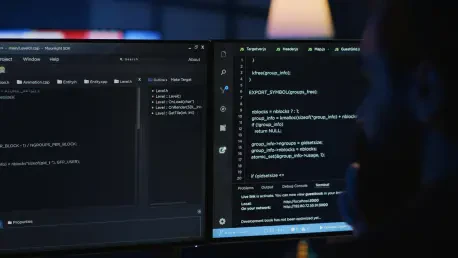Imagine a digital landscape where nearly every interactive website, mobile app, and server-side solution hinges on a single programming language. JavaScript powers over 98% of websites today, making it an indispensable tool for developers navigating the complexities of modern tech. This roundup dives into the nine critical concepts shaping JavaScript in 2025, drawing from a diverse pool of industry perspectives, tips, and debates. The purpose here is to synthesize expert opinions and practical advice, offering a comprehensive guide for developers aiming to elevate their skills in a rapidly evolving field. By exploring these insights, the goal is to illuminate how JavaScript continues to drive innovation across web development domains.
Why These Concepts Define Today’s JavaScript Landscape
JavaScript’s role as a cornerstone of web technology sparks continuous discussion among professionals about which skills matter most. Experts across forums, conferences, and tech communities agree that understanding modern JavaScript requires a blend of foundational knowledge and awareness of emerging trends. This section captures the consensus on why these nine concepts stand out, reflecting on their impact on scalability and efficiency in real-world projects.
Differing viewpoints emerge on the balance between mastering core language features and adopting new tools. While some seasoned developers advocate for a deep dive into syntax and mechanics, others emphasize the practicality of leveraging frameworks and automation. This roundup aims to bridge those perspectives, presenting a holistic view of what it takes to stay competitive in the current tech environment.
Expert Opinions on the 9 Vital Concepts
Revolutionizing Code with Functional Programming and Arrow Syntax
Functional programming has gained traction as a preferred approach for writing cleaner, more maintainable JavaScript. Industry voices highlight the transformative power of methods like map and filter, which enable declarative data handling over traditional imperative loops. The arrow operator (=>) often comes up as a favored feature for its concise syntax, especially in simplifying callbacks and event handlers.
However, not all opinions align on its universal application. Some developers caution against overusing arrow functions in performance-critical scenarios, suggesting that classic for loops might still hold an edge in specific use cases. This debate underscores a broader tip: adopt functional techniques thoughtfully, ensuring they align with project demands rather than following trends blindly.
A practical takeaway from community discussions is to experiment with small codebases first. By refactoring existing scripts with arrow syntax and functional methods, developers can gauge readability and performance impacts firsthand. This hands-on approach helps in striking a balance between modern style and practical execution.
Unpacking Scope and Closures for Stronger Codebases
Scope and closures remain fundamental to crafting robust JavaScript logic, with experts emphasizing their role in state management and data encapsulation. Tech leaders often point to closures as a powerful mechanism for creating private variables, particularly useful in modular design for applications. This capability is seen as essential for preventing unintended side effects in complex systems.
Contrasting views arise on the potential pitfalls of closures, especially regarding memory usage. Some professionals warn that improper handling can lead to leaks, bogging down applications over time. The advice here leans toward diligent testing and monitoring, ensuring that closures are released when no longer needed to maintain optimal performance.
A shared tip from coding communities is to leverage closures in utility functions for reusable logic. By designing small, self-contained modules, developers can harness this concept’s benefits while minimizing risks. Such strategies are often recommended as starting points for those looking to deepen their grasp of JavaScript’s inner workings.
Navigating the Complexities of this Keyword
The this keyword continues to be a sticking point in JavaScript, with many in the field acknowledging its context-dependent behavior as a frequent source of bugs. A widely appreciated solution, noted across developer blogs and panels, is the use of arrow functions to lock this to its lexical scope, particularly in event-driven programming like UI interactions.
Dissenting opinions question whether reliance on such fixes masks a deeper need for language reform. A segment of the community argues that while arrow functions help, they don’t address the root unpredictability, pushing for an educational focus on binding methods as a complementary skill. This perspective values a comprehensive understanding over quick workarounds.
Practical guidance often centers on consistent debugging practices. Experts suggest logging this values during development to uncover binding issues early, especially in nested functions or callbacks. This habit, paired with selective use of arrow syntax, forms a solid defense against common context-related errors.
Transforming UI with Reactivity and Component Design
Reactivity paired with component-based architecture garners praise for revolutionizing client-side development. Many framework advocates, particularly those aligned with React and Svelte, stress how these paradigms automate state updates, freeing developers from manual DOM manipulation. This efficiency is often cited as a game-changer for building dynamic user experiences.
On the flip side, a vocal group of purists raises concerns about over-dependence on frameworks. They argue that neglecting vanilla JavaScript in favor of reactive tools can erode core skills, leaving developers vulnerable when troubleshooting outside framework boundaries. This tension fuels ongoing discussions about maintaining a balanced skill set.
A recurring tip is to prototype projects both with and without frameworks. By comparing the development process, coders can better appreciate the strengths of reactivity while identifying scenarios where simpler solutions suffice. This comparative learning approach is widely endorsed as a way to build versatile expertise.
Harnessing Full-Stack Frameworks and Build Tools
Full-stack frameworks like Next.js and SvelteKit receive acclaim for unifying client and server-side development. Tech influencers often highlight how these tools, alongside build systems like webpack, streamline workflows by automating code transformation and optimization. Such integration is viewed as critical for handling the complexity of enterprise-level applications.
Critics, however, point out the learning curve and potential bloat associated with these ecosystems. Some developers note that smaller projects might not justify the overhead, advocating for lightweight alternatives or custom setups. This divide emphasizes the importance of aligning tool choices with project scale and goals.
A common piece of advice is to start with tutorials focused on build configurations. Understanding how tools like Vite or webpack operate under the hood empowers developers to customize pipelines effectively. This foundational knowledge, as many suggest, prevents blind reliance on default settings and enhances deployment outcomes.
Streamlining Workflows with CI/CD and Serverless Deployments
Continuous Integration and Continuous Deployment (CI/CD) practices, coupled with serverless platforms like Vercel, are lauded for reducing deployment friction. Industry feedback often celebrates how these systems automate testing and rollout, allowing teams to focus on coding rather than infrastructure. This automation is seen as a cornerstone of agile development in JavaScript projects.
Skeptics caution against viewing serverless as a one-size-fits-all solution. Challenges like cost unpredictability at scale or vendor lock-in are frequently mentioned as drawbacks to weigh. The consensus leans toward thorough evaluation of long-term needs before committing to such platforms.
An actionable suggestion from deployment specialists is to integrate CI/CD early in project cycles. Setting up automated pipelines from the outset, even for small applications, builds familiarity with workflows and minimizes errors during scaling. This proactive stance is often recommended to keep pace with modern delivery demands.
Exploring Server-Side JavaScript Capabilities
Server-side JavaScript, primarily through Node.js, garners attention for extending the language’s reach beyond browsers. Experts frequently commend the event loop’s role in handling asynchronous tasks, a feature deemed vital for scalable back-end solutions. Knowledge of HTTP protocols and API design also ranks high in importance for server-side proficiency.
Diverging opinions surface on runtime choices, with some favoring newer options like Deno for security features over Node.js’s established ecosystem. This debate reflects a broader push for innovation versus stability in server environments. Developers are encouraged to assess trade-offs based on specific use cases.
A practical tip shared across communities is to simulate server loads during testing. By mimicking real-world traffic, coders can optimize event loop performance and identify bottlenecks early. This hands-on method is often highlighted as a way to build reliable back-end systems with JavaScript.
Staying Current with ECMAScript Evolutions
Keeping up with ECMAScript updates is a recurring theme among JavaScript professionals, who stress the value of new language features for enhancing code efficiency. Annual releases introduce capabilities like advanced iterators, often cited as boosts to functional programming. Staying informed is seen as a competitive edge in leveraging the latest standards.
Some in the field argue that chasing every update can distract from mastering existing tools, advocating for selective adoption of new syntax. This viewpoint prioritizes depth over breadth, suggesting a focus on features with immediate project relevance. The balance between innovation and stability remains a key discussion point.
A widely shared recommendation is to follow ECMAScript proposals through technical blogs or community forums. Engaging with draft features before finalization offers insight into upcoming changes, allowing developers to prepare for integration. This proactive learning habit is often touted as essential for staying ahead.
Integrating JavaScript with AI Innovations
The intersection of JavaScript and artificial intelligence sparks excitement, with libraries like TensorFlow.js enabling machine learning directly in web apps. Tech enthusiasts often point to the accessibility of pre-trained models as a democratizing force, bringing AI capabilities to front-end developers. This trend is viewed as a frontier for innovation.
Cautionary notes come from those concerned about performance limitations in browser-based AI. Running complex models client-side can strain resources, leading some to suggest server-side processing as a more practical alternative. This split in approach highlights the need for strategic planning in AI integration.
A practical piece of advice is to start with small AI experiments, such as simple classification tasks using JavaScript libraries. These low-stakes projects help developers understand model constraints and integration challenges without overwhelming project scopes. Such incremental steps are frequently encouraged as entry points into this emerging field.
Reflecting on Shared Wisdom and Next Steps
Looking back, this roundup distilled a wealth of insights from across the JavaScript community, revealing both consensus and contention on the nine vital concepts. From the elegance of functional programming to the promise of AI integration, experts provided a roadmap for navigating the language’s vast potential. Debates around framework reliance, serverless scalability, and ECMAScript adoption underscored the nuanced challenges developers face.
Moving forward, the focus should shift to actionable growth. Developers are encouraged to prioritize hands-on projects that blend core concepts like closures with modern tools like reactive frameworks. Exploring open-source contributions can also sharpen skills while giving back to the community. Additionally, staying engaged with evolving standards through technical discussions ensures readiness for future shifts in the JavaScript ecosystem. These steps pave the way for sustained mastery in a dynamic field.








